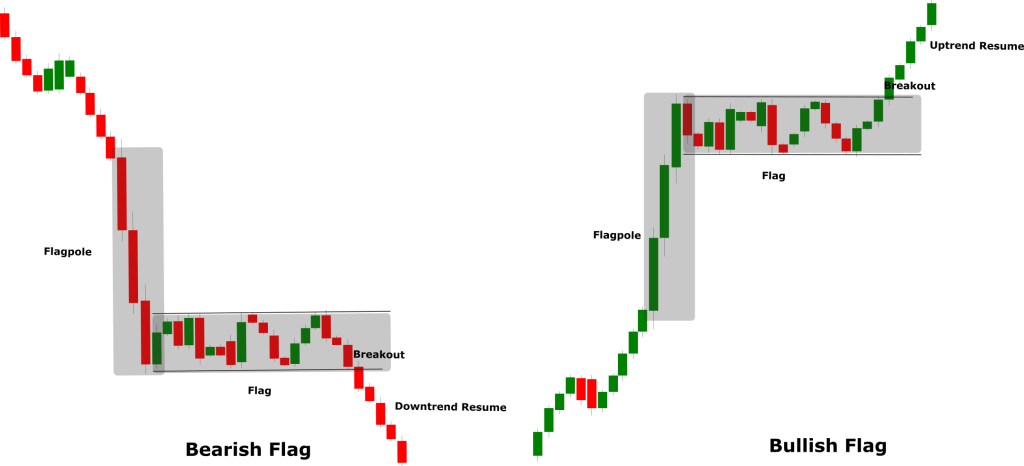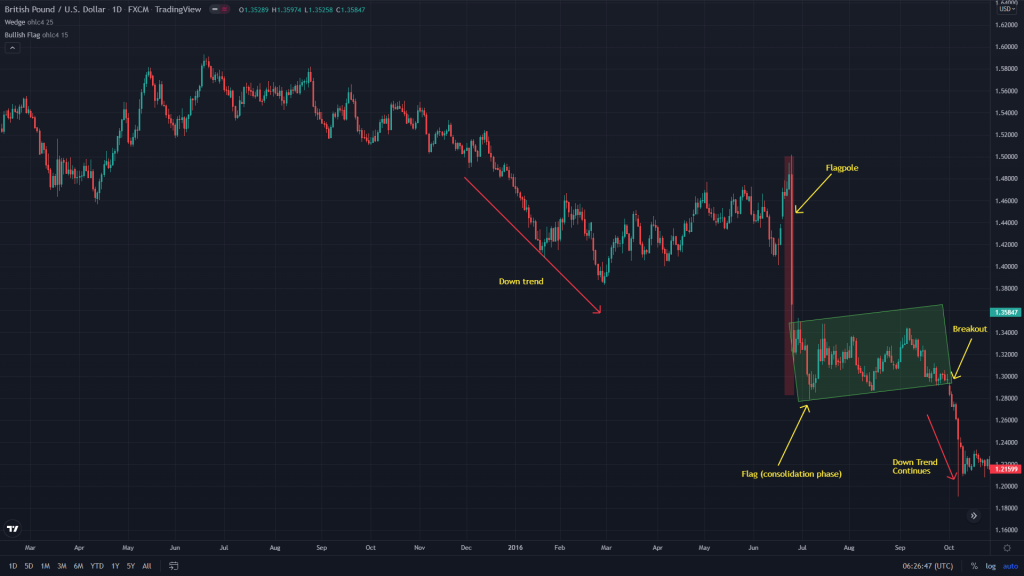Flag Pattern
The Flag is a continuation pattern that forms in both the up-trending and down trending markets. The pattern indicates the continuation of an ongoing trend and provides the opportunity to enter a trade in the direction of the trend. The pattern is formed when the price of an asset sharply moves up or down and then enters a consolidation phase. The sharp move creates the pole while the consolidation phase creates the flag. The flag is kind of a small rectangle and usually slopes in the opposite direction of the trend. A breakout from the flag completes the pattern and confirms the continuation of the prevailing trend.
A flag pattern in an uptrend is called the bullish flag while in a downtrend it is called the bearish flag. The structure of both the bearish and bullish flags is the same except for the trend direction.
Pattern Anatomy
The Flag is a continuation pattern therefore a prior uptrend should be in place for the validation of the pattern.
The volume should be very high during the first phase of the flag pattern and should subsequently decline towards the consolidation phase. The increasing volume towards the end of the consolidation phase will be an indication of an upcoming breakout.
The flag is a short-term pattern and its duration should be from a couple of weeks to a month. If the duration of the flag extends over a long period it may take another shape like the rectangle or the triangle pattern.
The formation of the flag pattern should start with a heavy volume which gradually declines as the pattern proceeds and enters the consolidation phase.
Ideally but now always a pole should break resistance or support line and the length of the pole should be of a reasonable size to qualify as the pole of the pattern.
The flag is a consolidation phase or the sideways trading range which is marked by two parallel lines. The slope of the flag should be in the opposite direction of the ongoing trend. For example, if it’s a bullish flag the slope should be downwards, and if it’s a bearish flag the slope of the flag should be upwards.
Using The Pattern
Although the flag patterns are very common even then traders should take proper measures to correctly identify the pattern. The flag patterns must be formed by a sharp move. For example, if it’s a bullish flag there should be a sharp upwards move. Likewise, if it’s a bearish flag there should be a sharp downwards move. If the pattern is created with the low volume it could be a deceptive pattern and traders should not enter in the trade. The volume is the key in this pattern and should not be ignored. A breakout from the flag with low volume could well be a fake-out. It is also a good practice to enter a trade only after the breakout is confirmed in the next couple of sessions.
The following chart of Microsoft (MSFT) highlights the significance of a Bullish flag pattern in an uptrend. The stock had been rising from $21. A higher gap opening (sharp move) towards $24 is followed by a small consolidation phase. The sharp move created the flagpole while the consolidation phase created the flag. The flag has also a small downwards slope. Soon after the consolidation phase the share price broke above the flag and completed the bullish flag pattern and gave the trend continuation signal. Following the signal, the uptrend resumed and the share price moved towards $30.
The following chart of GBP/USD is a classic example of a bearish flag. The pair had been gradually trending lower from 1.5600. The downwards momentum accelerated around 1.5000 and the pair sharply declined towards 1.3500. The decline is then followed by a consolidation phase. The sharp decline created the flagpole and the consolidation phase created the flag. The flag slope is also slightly upwards. The pair soon breached below the consolidation phase which completed the bearish flag pattern and signals the continuation of the downtrend. Following the signal, you can see the downtrend resumed and the pair moved further lower towards 1.2100.
Trade Setup Using Flag Pattern
The flag pattern is a continuation pattern and traders use this pattern to place the trades in the direction of the ongoing trend. The trade setup using the flag pattern is fairly simple.
In the scenario of a bullish flag, the long trade (buy) is placed after the price breaks above the flag. To confirm the breakout traders must wait for at least two sessions before entering the trade.
For the short-term traders, the stop-loss is generally kept below the support line of the consolidation phase. For the long-term traders, the ideal stop-loss level will be just below the bottom of the flag.
The take profit in this trade setup is generally kept just below the next resistance level. Another way to determine the take profit is by measuring the distance of the low and the high of the flagpole and dividing it by 2. For example, if you are trading forex and the distance between the pole high and low is 100 pips then take profit will be 50 pips away from the entry point.
In the scenario of a bearish flag pattern, a short (sell) trade is placed after the price breaks below the flag. For the short-term traders, the stop-loss is kept above the flag resistance line while for the long-term traders the ideal stop-loss level is just above the top of the pole. The take profit in this trade setup is placed just before the next support level or by measuring the distance between the pole high and low and dividing distance by two.



